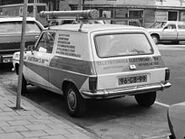
The Simca 1100 is a car built from 1967 to 1982 by Chrysler Europe's division Simca. It was replaced by the (Simca) Talbot Horizon.
History[]
The 1100 was the result of "Project 928", started in 1962, finalized by engineers Philippe Grundeler and Charles Scales. The design was a result of Simca's market research in the early 1960s, which showed the increasing popularity of front wheel drive cars that provided better utilization of space and comfort in small cars. In Spring 1962, Simca organized a 1966–67 launch of a new range of front wheel drive cars with saloons, estates cars and light commercial vehicles to be included, all fitting into France's 6CV tax class – between the Simca Mille and Simca 1300. Both transverse and longitudinal engine placement were tested, and in 1963 the transverse-engine design was approved. The Simca 1100 was one of the first designs outside Fiat to feature a transverse engine with an end-on gearbox and unequal length driveshafts (now near-universal amongst small cars), a possible result of Fiat influence as a major shareholder. In 1963, Chrysler took a controlling interest in Simca, approving the project in 1964, with a production target of summer 1967. The short timetable included developing a new transmission, and using a larger version of the rear engined rear wheel drive Simca Mille (Simca 1000) "Poissy engine", displacing 1118 cc (the Mille used a 1.0 litre engine, the 1500 a 1.5 liter engine).
Introduction[]
When first shown on Sardinia and at the Paris Auto Show in 1967, the 1100 was advanced in design, featuring a hatchback with folding rear seats, disc brakes, rack and pinion steering, an independent front (double wishbone) and rear (trailing arm) suspension using Chrysler-style torsion bars (though Chrysler itself only used them at the front), and a full range of controls. Numerous permutations were available, with a manual, automatic and semi-automatic transmission. The engine was slanted to allow for a lower bonnet; and the engine, gearbox, and suspension were carried on a subframe to allow the unibody to be relatively unstressed. In American fashion, the body was welded to the frame, not bolted. The 1100 was reportedly studied closely by Volkswagen when the latter company was designing its Volkswagen Golf, after making rear-engined, rear-wheel-drive vehicles.
Models[]
The 1100 was (along with the pricier Renault 16 & Austin Maxi), one of the first hatchback designs, with a folding rear seat and in three and five-door variations. Different equipment levels were defined by LS, GL, GLS and "Special" tags. Three- and five-door estate cars were also included in the range.
The car was fitted with Simca Type 315 petrol OHV "Poissy engines" with 944, 1118, and 1294 cc variants, depending on year and market. A "stroked" 1118 cc engine displacing 1.2 litres was introduced in 1971 to the UK market as the Simca 1204. It was also sold in the USA in limited quantities. In 1974, the sporty TI appeared with the 1294 engine (82 PS), at the time when the car also saw a cosmetic redesign. Based on the 1100 chassis, the Matra engineering firm created a crossover derivation named Matra Rancho.



